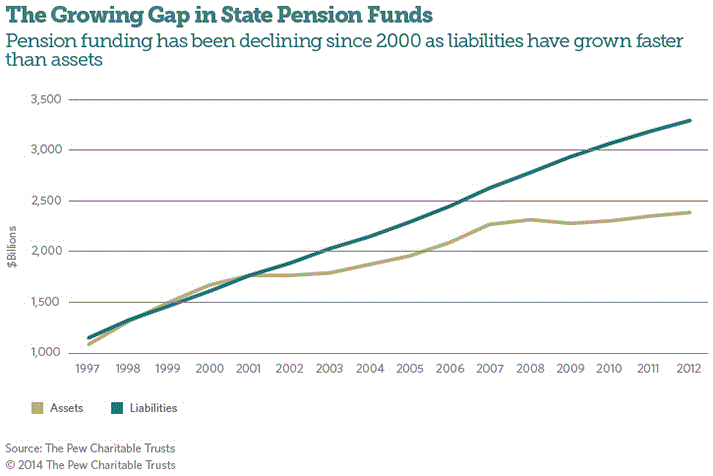The Fiscal Health of State Pension Plans: Funding Gap Continues to Grow
March 1, 2014 - The PEW
Full Fact Sheet
Download
This fact sheet has been revised since initially issued to reflect updated data and feedback from five states (ID, MD, NH, NJ, SD). As a result, total pension debt facing state pension plans has been revised to $915 billion from $914 billion. Pew analysis also shows that 15 states made their full contributions rather than 14.
Based on the most recent comprehensive data, the gap between what state and local governments have promised in pension benefits to their workers and the funding to meet those obligations continues to widen. New data for fiscal year 2012 show that state-run retirement systems had a $915 billion shortfall. When promises by local governments were factored in, the total pension debt was over $1 trillion.
Since the financial crisis of 2008, policymakers have increasingly focused attention on the fiscal health of staterun retirement systems. A combination of investment return shortfalls, missed contributions, and unfunded benefit increases had left states with a $452 billion unfunded liability for pensions in fiscal 2008; by 2010 this funding gap had grown to $757 billion.
In spite of recent strong investment returns, the new data show that the funding gap for state plans has continued to growincreasing by $158 billion from 2010 to 2012. This figure represents 14 percent growth, adjusted for inflation, and is primarily the result of states continuing to acknowledge the investment losses suffered in fiscal 2009. Because most state pension plans smooth out gains and losses over five years, they would not finish absorbing the impact of the market collapse until fiscal 2013.
Many states have enacted reforms since the financial crisis hit. And if pension plans meet their investment return targets and government sponsors make recommended contributions to their retirement systems, states can expect to see funding levels start to rise in future years. But investment returns are uncertain, and policymakers in many states fell short of paying for pension debt in 2012, an aggregate shortfall of $21 billion. Only 15 states have consistently made at least 95 percent of the full actuarially required contributions for their pension plans from 2010 through 2012; the remaining 35 states fell short in at least one year.

Pewfs work on public-sector retirement systems is conducted in partnership with the Laura and John Arnold Foundation.